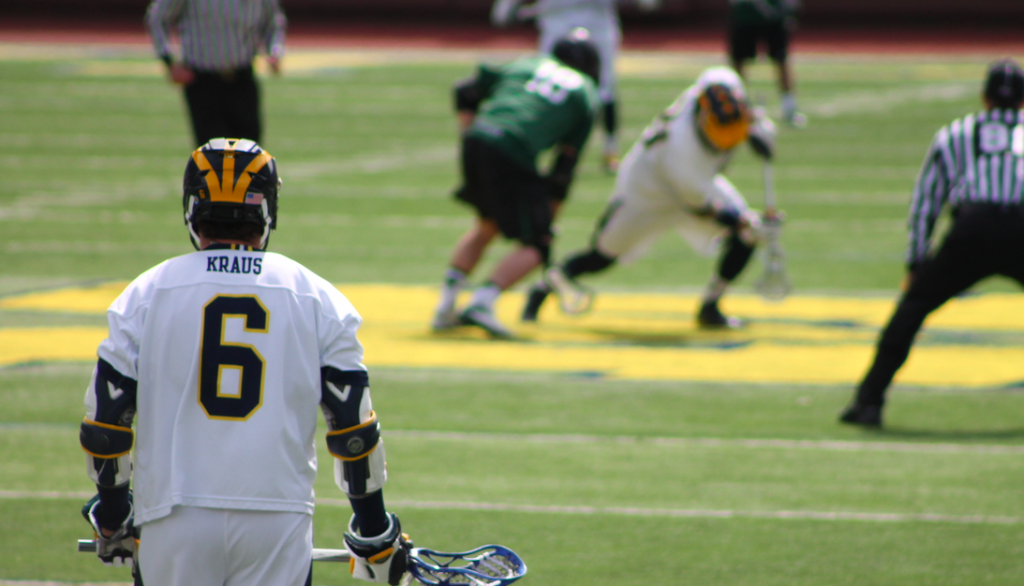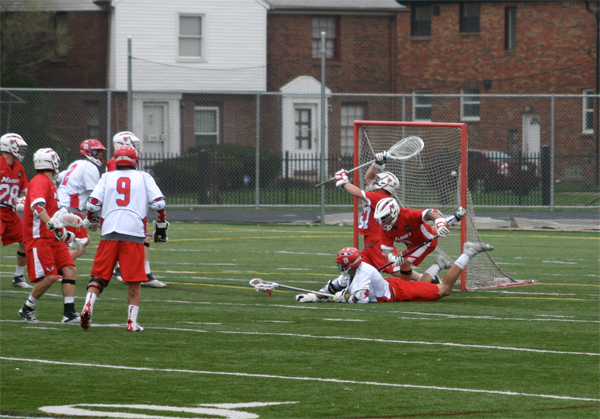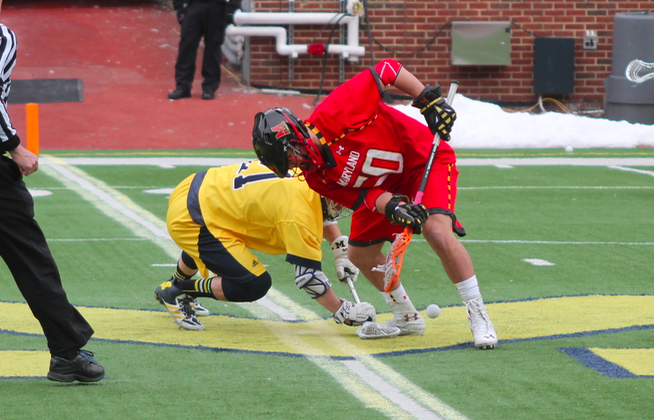
The Maize and Blue may want to forget they watched a lot of the 2016 season. (Photo by Tim Sullivan/Great Lax State)
After what had looked like steady progress through the first four years of the program – 1-13 records in the first two years, then 5-11 in 2014, 5-8 (with the program’s first conference win) in 2015 – this spring was a 3-10 dud for the Maize and Blue. Climbing from No. 58 to 54 to 49 to 43 in the LaxPower computer rankings, they slid back to No. 48 this season.
Some of this is certainly explicable. They likely didn’t suffer more injuries than other teams, but in terms of key injuries, the program’s two all-time leading scorers missing a handful of games at the same time (and a few on either side without one or the other), along with a three-year starter on defense missing the entire year is about as bad as it gets. Some of it is less explicable: giving a terrible Dartmouth team its only win of the season and falling to the MAAC’s second-place team (Marist) in back-to-back home games leaves a sour taste in the mouth. If the Wolverines simply take care of business in those two, the amount that this season leaves a bad taste in the mouth is reduced in a major way.
So, how much is one-year hiccup and how much is the program reaching a bit of a plateau early in its existence? The obvious, reasonable answer is that the majority is the former (don’t tell the message boarders that, of course), but the coaching staff has some serious answers to find for 2017, as well.
Here’s the statistical profile for the season:
| Michigan Wolverines 2016 |
| Michigan |
Opponents |
| Faceoff Wins |
178 |
Faceoff Wins |
156 |
| Clearing |
197-232 |
Clearing |
197-228 |
| Possessions |
441 |
Possessions |
419 |
| Goals |
122 |
Goals |
166 |
| Offensive Efficiency |
.277 |
Offensive Efficiency |
.396 |
Thanks almost entirely to faceoff specialist Brad Lott, Michigan had a slight advantage in the possession game on the year (clears were almost dead even). However, while the offense was decent, the defense was simply bad, thus the Wolverines didn’t have a great year.
What Went Well
Unfortunately, a lot of things in this section are going to be in the departing category, including Lott. He struggled a couple years ago when the faceoff rules changed, but was outstanding in this, his final year in the winged helmet.
Moving Kyle Jackson to attack, where his skillset seems a bit more natural, and where he could share a line with Ian King (on the rare occasion both were healthy) worked very well. The U-M offense was particularly good when that duo was able to see the field together, and though it struggled at other times, we got a glimpse of what can be when Michigan has not just a good starting lineup, but full depth to overcome some of those losses.
After a few years of playing a very conservative defense style (which didn’t go particularly well), Michigan played a relatively aggressive scheme this year (which, to be fair, went worse). That had its downsides, no doubt, but did result in a fair number of caused turnovers defensively. I would assume that the shift was in part due to playing lots of youth on defense (juniors Stefan Bergman and Andrew Hatton were out for significant stretched, senior Chris Walker missed a pair of games, where it’s easier to say “go get it” than to have them mentally executing your best schemes on an every-trip basis. Being able to do both in the future will be a boost.
In that regard, the amount of playing time for youngsters in general was something that helps going forward. It could probably fit into any of the three headings in this post though, since it certainly stunk for the outcome of the 2016 season, but portends bright things for the future.
Room For Improvement
The defense was straight-up bad. As mentioned above, there are some reasons for this – you don’t expect to have to use freshman starters for 12 of 39 (Michigan lists four starting positions with the LSM not considered a starter, 13 games) possible openings, for one thing – but at a certain point, you have to find a way to cope with it, even if the depth and talent in the program isn’t what outsiders want to expect out of a fifth-year program – it’s closer to a second- or third-year group, thanks to the club transition.
The Wolverines hung goalie Gerald Logan out to dry quite a bit, with early (or extremely late) slides resulting in the majority – .572 – of opponent scores being assisted. He’s a better keeper than his career-low .509 save percentage would have you think, and the players in front of him need to be better. Youth movement, etc., etc., but wasting a talent like him between the pipes is bad either way.
Offensively, Michigan wasn’t a poor team this year, but they do have one are in which they can take things to the next level: taking care of the ball. They turned it over 185 times on the year (.420), well over their number of goals, whereas opponents saw exactly the same number of offensive opportunities end in a goal as in a turnover. Reducing the number of possessions that are simply wasted goes a long way to straightening things out. Unfortunately some of Michigan’s best returning players (Ian King, Mikie Schlosser, Decker Curran) were responsible for a big portion of that turnover mark – though, to be fair, that’s because they’re expected to do a lot of the ball-handling – so individual improvement will be the key to taking that next step.
The biggest thing that jumps out as room for improvement is a little less concrete and stats-based than those immediately above, but it’s the difference between a letdown year and continuing slow, steady progress: taking care of business in games that should be won. U-M played one of the toughest schedules in the country (three of four final four teams, including both finalists), but there were chances in there to get some wins, and too many of those chances fell by the wayside. A team that wants to go where Michigan wants to go shouldn’t drop back-to-back home games against Dartmouth and Marist: it should win both. They should be able to steal one themselves against Ohio State (a three-goal loss), Penn (a two-goal loss), and Maryland (a one-goal loss – and what could have been a signature moment over the eventual national runner-up). Add in that a potential win against Detroit was canceled due to weather, and this season should have looked better than it did.
The Distant Future
Fortunately for Michigan, even a relatively trying season can be seen as growing pains. The number of freshman contributors (in addition to the defenders mentioned above, 18 other man-games were started by freshmen) was crappy for the outcome of the 2016 season, but should pay dividends in 2017 and beyond. So too should those close losses, even those that came against opponents where “close loss” might as well be “didn’t show up.”
The Wolverines’ roster isn’t yet where outsiders expect it to be, and that’s fine, but more in-depth observers should be cognizant of how that changes the expectations. The sophomore class that was on the field this spring was probably the first full, Division-1 recruiting class that this staff brought in. While the senior and junior groups have brought some outstanding individual players (Gerald Logan Kyle Jackson, Ian King, to name a few) to Ann Arbor, in terms of full depth of talent throughout a group – and not just getting lucky to hit on a couple guys here and there – you should see, going forward, what is expected of a real life D-1 squad.
For 2017 in specific, there are a couple personnel questions to be answered, and some that could have a major impact. Goalie Gerald Logan, defenseman Charlie Keady, and midfielder Brendan Gaughan all mised a full season due to injury at some point during their careers (2014 for Logan and Keady, 2013 for Gaughan), and could return as redshirt seniors next spring. No official announcements have been made as to whether any of the three are returning, but current expectation is that Gaughan is the only of the three to return. Logan has a solid replacement in Robbie Zonino, Gaughan has played just limited minutes in his three active years, and I’ve already extensively discussed the influx of youth on close D, but some experience – and obvious talent – added to the roster can’t be construed as a bad thing, either.
Michigan will have to make up for some personnel losses even if some of those guys return. Kyle Jackson is the first NCAA-era pro (Brekan Kohlitz and Trevor Yealy, both primarily from the club days, had opportunities with MLL and NLL teams, respectively) from this program, picked up by the Boston Cannons. He also happens to be the program’s all-time leading scorer. While he’ll almost certainly be passed by Ian King if the rising senior can remain healthy next spring, Jackson leaves a big void. Peter Kraus and Mike Hernandez will also leave a sizable void offensively, while all the talented up-and-comers in the world won’t make Michigan forget about LSM Chase Brown.
Faceoffs will be a question mark after Michigan’s non-Lott players struggled, and Lott exhausting his own eligibility. There should be bullets in the chamber (incoming freshman Matt Dellacroce is highly-regarded, players on the roster can improve, and there may be a high-profile transfer or two available), but Life Without Lott will be something for the program to adjust to.
The Wolverines’ 2016 was a poor season, but may have actually been what was needed for 2017 to be a major step forward for the program. This time of year is when the team has to capitalize on what they learned this spring to forget all about it in less than nine months’ time.



